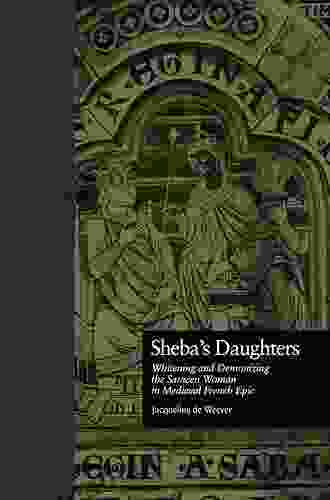Whitening and Demonizing the Saracen Woman in Medieval French Epic Garland

The Saracen woman is a complex and evolving figure in medieval French epic garland. She is often depicted as a beautiful and desirable object of desire, but she is also frequently demonized as a treacherous and evil temptress. This article explores the complex and evolving representation of Saracen women in medieval French epic garland. It argues that these representations were shaped by a variety of factors, including the political and religious tensions of the time, as well as the prevailing cultural norms and values.
4 out of 5
| Language | : | English |
| File size | : | 842 KB |
| Text-to-Speech | : | Enabled |
| Screen Reader | : | Supported |
| Enhanced typesetting | : | Enabled |
| Print length | : | 364 pages |
| Paperback | : | 130 pages |
| Item Weight | : | 6.4 ounces |
| Dimensions | : | 5.85 x 0.33 x 8.27 inches |
The Saracen as the Enemy
The Saracen was a common enemy of the Franks in the Middle Ages. They were seen as a threat to both the Christian faith and the Frankish kingdom. This was due in part to the fact that the Saracens were Muslims, and the Franks were Christians. The two religions were often seen as incompatible, and the Saracens were seen as a threat to the Christian way of life.
In addition to their religious differences, the Saracens were also seen as a political threat to the Frankish kingdom. The Saracens had conquered a large amount of territory in the Middle East and North Africa, and they were seen as a potential threat to the Frankish kingdom. This was especially true after the Saracens defeated the Visigoths in the Battle of Poitiers in 732 AD.
The Saracen Woman as a Sex Object
Despite the fact that the Saracens were seen as a threat to the Frankish kingdom, Saracen women were often depicted as beautiful and desirable objects of desire. This was due in part to the fact that Saracen women were often seen as being more exotic and sensual than Frankish women. They were often described as having dark hair, dark eyes, and olive skin. They were also often depicted as being wearing revealing clothing.
The beauty of Saracen women was often used to justify the violence that was committed against them. In the Song of Roland, for example, the Saracen princess Aude is described as being "more beautiful than any flower." However, she is also described as being a "traitor" and a "heathen." This duality of beauty and evil is a common theme in the representation of Saracen women in medieval French epic garland.
The Saracen Woman as a Demon
In addition to being depicted as beautiful and desirable objects of desire, Saracen women were also often demonized as treacherous and evil temptresses. This was due in part to the fact that Saracen women were often seen as being associated with the devil. In the Song of Roland, for example, the Saracen princess Aude is described as being "the devil's daughter." This association with the devil made Saracen women seem even more dangerous and threatening.
The demonization of Saracen women was also used to justify the violence that was committed against them. In the Song of Roland, for example, the Saracen princess Aude is killed by Roland after she tries to seduce him. This act of violence is justified by the fact that Aude is seen as being a threat to the Christian faith.
The representation of Saracen women in medieval French epic garland is a complex and evolving one. They are often depicted as beautiful and desirable objects of desire, but they are also frequently demonized as treacherous and evil temptresses. This duality of beauty and evil is a reflection of the complex and contradictory attitudes that the Franks had towards the Saracens. They were seen as a threat to the Christian faith and the Frankish kingdom, but they were also seen as being beautiful and desirable. This duality of attitudes is reflected in the representation of Saracen women in medieval French epic garland.
4 out of 5
| Language | : | English |
| File size | : | 842 KB |
| Text-to-Speech | : | Enabled |
| Screen Reader | : | Supported |
| Enhanced typesetting | : | Enabled |
| Print length | : | 364 pages |
| Paperback | : | 130 pages |
| Item Weight | : | 6.4 ounces |
| Dimensions | : | 5.85 x 0.33 x 8.27 inches |
Do you want to contribute by writing guest posts on this blog?
Please contact us and send us a resume of previous articles that you have written.
 Top Book
Top Book Novel
Novel Fiction
Fiction Nonfiction
Nonfiction Literature
Literature Paperback
Paperback Hardcover
Hardcover E-book
E-book Audiobook
Audiobook Bestseller
Bestseller Classic
Classic Mystery
Mystery Thriller
Thriller Romance
Romance Fantasy
Fantasy Science Fiction
Science Fiction Biography
Biography Memoir
Memoir Autobiography
Autobiography Poetry
Poetry Drama
Drama Historical Fiction
Historical Fiction Self-help
Self-help Young Adult
Young Adult Childrens Books
Childrens Books Graphic Novel
Graphic Novel Anthology
Anthology Series
Series Encyclopedia
Encyclopedia Reference
Reference Guidebook
Guidebook Textbook
Textbook Workbook
Workbook Journal
Journal Diary
Diary Manuscript
Manuscript Folio
Folio Pulp Fiction
Pulp Fiction Short Stories
Short Stories Fairy Tales
Fairy Tales Fables
Fables Mythology
Mythology Philosophy
Philosophy Religion
Religion Spirituality
Spirituality Essays
Essays Critique
Critique Commentary
Commentary Glossary
Glossary Bibliography
Bibliography Index
Index Table of Contents
Table of Contents Preface
Preface Introduction
Introduction Foreword
Foreword Afterword
Afterword Appendices
Appendices Annotations
Annotations Footnotes
Footnotes Epilogue
Epilogue Prologue
Prologue Gabbie Hanna
Gabbie Hanna Kate Manne
Kate Manne Joann Klusmeyer
Joann Klusmeyer Grace Lewis
Grace Lewis Drew Lindsay
Drew Lindsay Lori Stade
Lori Stade Eric Chabot
Eric Chabot Lizzie Huxley Jones
Lizzie Huxley Jones Patrick D Hahn
Patrick D Hahn Victor Johnson
Victor Johnson Kerry Murphy
Kerry Murphy Captivating History
Captivating History Jared Wynn
Jared Wynn Viktor Vagon
Viktor Vagon Katarina
Katarina Keisha Lindsay
Keisha Lindsay Jeff Kass
Jeff Kass Jim Bryant
Jim Bryant Marla Cilley
Marla Cilley Mark Dunn
Mark Dunn
Light bulbAdvertise smarter! Our strategic ad space ensures maximum exposure. Reserve your spot today!

 Eugene PowellPlants vs. Zombies: Timepocalypse by Paul Tobin: An Epic Journey Through the...
Eugene PowellPlants vs. Zombies: Timepocalypse by Paul Tobin: An Epic Journey Through the... Dean CoxFollow ·4.5k
Dean CoxFollow ·4.5k Daniel KnightFollow ·10.6k
Daniel KnightFollow ·10.6k Carl WalkerFollow ·4.5k
Carl WalkerFollow ·4.5k Jake PowellFollow ·14.3k
Jake PowellFollow ·14.3k Gregory WoodsFollow ·10.7k
Gregory WoodsFollow ·10.7k Gage HayesFollow ·16k
Gage HayesFollow ·16k John Dos PassosFollow ·7.1k
John Dos PassosFollow ·7.1k Bernard PowellFollow ·17.9k
Bernard PowellFollow ·17.9k

 Ernest Powell
Ernest PowellBenefits of Corporal Punishment: A Review of the...
Corporal punishment is a form of physical...

 Bobby Howard
Bobby HowardThe Development and Significance of African American...
African American...

 Guy Powell
Guy PowellDown Girl: The Logic of Misogyny - A Comprehensive...
In her groundbreaking work,...

 Forrest Blair
Forrest BlairThe Bikini Changing Room: A Micro Mini Romance
In the heart of...
4 out of 5
| Language | : | English |
| File size | : | 842 KB |
| Text-to-Speech | : | Enabled |
| Screen Reader | : | Supported |
| Enhanced typesetting | : | Enabled |
| Print length | : | 364 pages |
| Paperback | : | 130 pages |
| Item Weight | : | 6.4 ounces |
| Dimensions | : | 5.85 x 0.33 x 8.27 inches |














